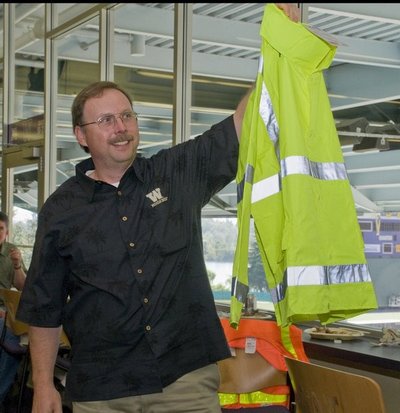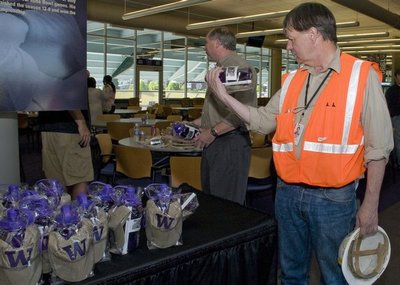September 25, 2008
‘Safety Stand Down’: Honoring construction workers and stressing safe practices
At any given time there is a small army of workers on the UW campus who are not employed by the University. They’re the construction workers who, as employees of contracting firms, build the state-of-the-art facilities that help to attract the very best faculty and staff to the UW.
Earlier this month, the University honored about 400 of those workers with a first-ever “Safety Stand Down” at the Don James Center. A Safety Stand Down, according to Capital Projects Safety Director Ron Fouty, is a campuswide event where all construction jobs stop for a given period of time so that the workers, their bosses and University officials can gather to talk about safety on the job.
And to have a little fun, too. “We wanted to not only discuss safety with the workers, but also to really celebrate them and thank them for the good job they’re doing,” Fouty said. “We can’t build the University without them.”
Workers attending the event were greeted with a gift pack containing a water bottle, baseball cap and other items, and they enjoyed lunch from Longhorn Barbecue. Prizewinners in a raffle walked away with footballs, tools and more.
The featured speakers were Mike Sotelo and Jim Lambright. Sotelo, who is the CEO of Approach Management Services and chairman of the board of the Washington State Hispanic Chamber of Commerce, is “a passionate safety guy,” Fouty said. Sotelo started his career as a carpenter for construction company WG Clark and worked his way up, so he can relate to the average worker.
Lambright, a former Husky football coach, is now a consultant who talks about construction workers as athletes. “They make their living with their bodies just like the football players do, so physical conditioning and learning to work safely is very important,” Fouty said.
Part of Fouty’s job is to keep safety statistics for the University’s construction sites, and he said the record is very good. In fact, the injury rate at the UW is less than four injured per 100 employees, compared to the state’s average of more than eight per 100. (The University is compared to other sites constructing nonresidential buildings.)
“The suits understand the statistics,” Fouty said. “What the workers understand is, if you’re going to be working in Washington, look at 10 guys around you and one of those guys is going to get injured. So you ask, who wants to get hurt? Raise your hand. And obviously, nobody wants to be the one.”
So, what does the University do to try to prevent injuries?
A lot, it turns out. It begins when a construction project is still in the design phase. The construction manager, the project manager and the architect sit down with Fouty and do what they call a design phase hazard analysis. “We try to foresee what the hazards are going to be, how they can be mitigated and who’s going to be responsible to make sure the mitigation takes place,” Fouty said.
The analysis is then taken to the contractor, who is required to develop a site-specific safety plan, taking into account the hazards pinpointed in the analysis and others. The contractor has to submit its plan for review and acceptance. And when subcontractors come along, they also have to develop a site-specific plan that’s in compliance with the other one.
But thinking about safety doesn’t end there. Contractors also have to develop a job hazards analysis which looks at tasks performed on the job on a more microscopic level. Then foremen take the analysis and say OK, what work are we doing today and how can I anticipate and address the hazards? They develop task plans.
“So this carries the thought of safety down to the workers first thing when they step on a project site,” Fouty said. “This all happens before anyone picks up a tool. And as conditions change, they have to go back and rethink their plans.”
University officials meet with contractors on a weekly basis, Fouty said, and the first topic of discussion is safety. He and the UW construction managers also go out and walk job sites to see what’s going on. They talk with contractors and ask about problems they observe.
What seems like a very complicated process has paid off in low injury rates, and that holds true nationwide, Fouty said.
“The Construction Users Roundtable did some research and found that the greatest positive influence on safety that can be had is through interest and influence by the owners. When owners are involved in safety plans, their injury rates are dramatically lower.”
Fouty said Capital Projects plans to make the Safety Stand Down an annual event, because, despite all the planning, safety does come down to the individual worker. “If you want your message to reach them,” he said, “you’ve got to personalize it.”


